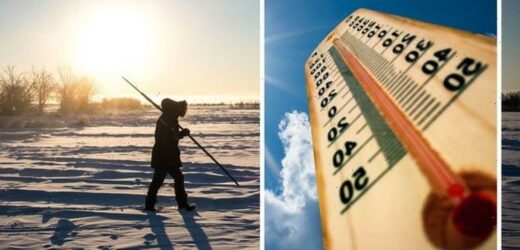Newsnight: Expert discusses keeping global warming below 1.5C
We use your sign-up to provide content in ways you’ve consented to and to improve our understanding of you. This may include adverts from us and 3rd parties based on our understanding. You can unsubscribe at any time. More info
The temperature was described as a ”Mediterranean” 100F (38C), the WMO confirmed in a statement. This temperature was recorded in the Siberian town of Verkhoyansk in June 2020. At the time, the town was at the peak of an extended heatwave, where temperatures across the region that summer averaged as much as 18F (10C) above normal.
In a statement, WMO’s secretary-general Petteri Taalas said: ”This new Arctic record is one of a series of observations reported to the WMO Archive of Weather and Climate Extremes that sound the alarm bells about our changing climate.”
The WMO noted that the extreme heat was “more befitting the Mediterranean than the Arctic” and that the heatwave was a key factor in ”fueling devastating fires, driving massive sea ice loss and playing a major role in 2020 being one of the three warmest years on record”.
Mr Taalas said: “WMO investigators are currently seeking to verify temperature readings of 54.4C recorded in both 2020 and 2021 in the world’s hottest place, Death Valley in California, and to validate a new reported European temperature record of 48.8C in the Italian island of Sicily this summer.
“The WMO Archive of Weather and Climate Extremes has never had so many ongoing simultaneous investigations.”


The Arctic is among the fastest-warming regions in the world where the rate of heating is more than twice the global average.
The extreme temperature and ongoing climate change prompted a WMO panel of experts to add a new climate category “highest recorded temperature at or north of 66.5C, the Arctic Circle” to its international Archive of Weather and Climate Extremes.
According to data taken from the Russian Forestry Agency, the wildfires in Siberia this year were the worst since records began.
They destroyed an area of more than 46 million acres (18.6 million hectares) of Russian forests in 2021 alone.

The smoke created from these forest fires were even detected travelling as far up as the North Pole.
The heatwave in Siberia led to horrifying effects even through the winter, as remote parts of the region were hit with some of nature’s most unrelenting wildfires that have continued to burn right through the brutal cold.
Peat fires, also known as “zombie fires,” get their name because they seem to be able to come back from the dead.
Summer wildfires appear to be extinguished on the surface. However, below ground, it is fuelled by peat and methane that have been built up for many millennia.
DON’T MISS:
Chris Whitty warns hospitals, pubs, shops and restaurants to CLOSE [INSIGHT]
Prince Louis spitting image of royal relative in new Christmas photo [REACTION]
Germany crisis: EU’s largest economy battered by rising inflation [REVEAL]


The thawing permafrost isn’t always enough to put out the fires as the gas gets released and brings the wildfire “back to life”.
Prof Randall Cerveny from the WMO said: “Fundamentally, this investigation highlights the increasing temperatures occurring for a climatically important region of the world.
“Through continued monitoring and assessment of temperature extremes, we can remain knowledgeable about the changes occurring in this critical region of the world, the polar Arctic.”
Source: Read Full Article


